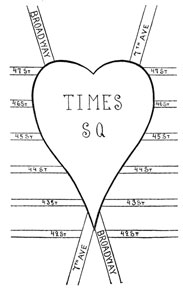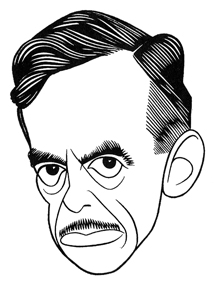Here are 10 things you should know about Will Rogers, born 144 years ago today. He was a hugely influential figure in nearly every aspect of American popular culture.
Tag: Madison Square Garden
Times Square Tintypes: Eugene O’Neill
THE GREAT GOD O’NEILL
Times Square Tintypes: Times Square
MY STREET
 FORTY-SECOND Street and Seventh Avenue . . . Everybody calls it Broadway. The Rialto Theatre. A hanging says it is “The House of Hits”. . . . But the big line is at the Paramount . . . Sightseeing buses . . . Old women sitting in them . . . Making a living as decoys . . . See the Bowery . . . A lecture through Chinatown . . . Why, all the Chinks own restaurants on Broadway . . . There ain’t no Chinamen in Chinatown . . . The chap who is shouting that he is going to point out the historic places . . . Did you know he only arrived here from Portland last week? . . . See the old man selling The Birth Control Review . . . He’s doing it for the wife and kiddies. . . .
FORTY-SECOND Street and Seventh Avenue . . . Everybody calls it Broadway. The Rialto Theatre. A hanging says it is “The House of Hits”. . . . But the big line is at the Paramount . . . Sightseeing buses . . . Old women sitting in them . . . Making a living as decoys . . . See the Bowery . . . A lecture through Chinatown . . . Why, all the Chinks own restaurants on Broadway . . . There ain’t no Chinamen in Chinatown . . . The chap who is shouting that he is going to point out the historic places . . . Did you know he only arrived here from Portland last week? . . . See the old man selling The Birth Control Review . . . He’s doing it for the wife and kiddies. . . .A million lights that dim the stars. . .”
Heart of the World . . .”
A helping hand—they’re all for sale,
On Broadway, Broadway. . . .
When you’re on top;
Same crowd hissing you and dismissing you
If you should flop . . .
Tomorrow is another day . . .
The Heart of the World. . . .”
Wonder city of the world!
An acquaintance of ours once wrote of New York City and its denizens:
“Even New Yorkers who have lived here all their lives are happy to sit back and chat away about the place as if they’d just come across it. It’s a regular topic of conversation. And what’s nice is that it’s neither particularly narcissistic nor self-loathing, this chatter, but more curious and delighted.”
We think that as apt and accurate a description of New Yorkers’ attitude toward their town as we’ve ever heard.
We find that New Yorkers not only like to talk about their town, to commiserate over its delights and surprises (and, yes, miseries) with one another, but most every New Yorker we know also likes to see the city on the silver screen (or perhaps the small screen at home). Even though we’re surrounded at all times by the hustle and bustle, the noise and hordes of people and row after row of concrete towers, most of us still get a kick out of seeing them depicted cinematically.
And it’s an even rarer treat to see the streets of the city as they once were, in old movies and promotional films.
The film we’re sharing with you today, “Flight to New York,” is a promo film for Trans-World Airlines, but it touts the Big Apple just as much as that now-defunct air carrier. It was shot in 1950, and most of the attractions featured in it are still around today. But there’s something about seeing them as they once were, captured in glorious black-and-white.
Enjoy.

